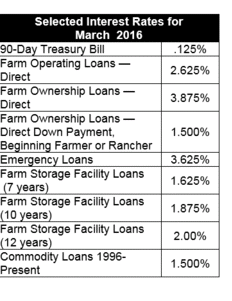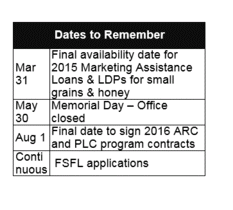|
 The microloan program, which celebrates its third anniversary
this week, has been hugely successful, providing more than
16,800 low-interest loans, totaling over $373 million to
producers across the country. Microloans have helped farmers and
ranchers with operating costs, such as feed, fertilizer, tools,
fencing, equipment, and living expenses since 2013. Seventy
percent of loans have gone to new farmers. The microloan program, which celebrates its third anniversary
this week, has been hugely successful, providing more than
16,800 low-interest loans, totaling over $373 million to
producers across the country. Microloans have helped farmers and
ranchers with operating costs, such as feed, fertilizer, tools,
fencing, equipment, and living expenses since 2013. Seventy
percent of loans have gone to new farmers.
Now, microloans will be available to also help with farm land
and building purchases, and soil and water conservation
improvements. FSA designed the expanded program to simplify the
application process, expand eligibility requirements and
expedite smaller real estate loans to help farmers strengthen
their operations. Microloans provide up to $50,000 to qualified
producers, and can be issued to the applicant directly from the
USDA Farm Service Agency (FSA).
This microloan announcement is another USDA resource for
America’s farmers and ranchers to utilize, especially as new and
beginning farmers and ranchers look for the assistance they need
to get started. To learn more about the FSA microloan program
visit www.fsa.usda.gov/microloans, or contact your local FSA
office. To find your nearest office location, please visit
http://offices.usda.gov.

USDA to Provide Agricultural Credit Training, Expand
Opportunities for Farmer Veterans and Beginning Farmers
USDA announced a partnership with the Farmer Veteran Coalition (FVC)
to conduct agricultural credit training sessions in the Midwest
for military veterans and beginning farmers and ranchers. States
under consideration to host the workshops include Iowa,
Illinois, Indiana, Michigan, Minnesota, Missouri, and Nebraska.
These workshops will provide individuals interested in farming
as a career, including military veterans, with methods to
improve business planning and financial skills, and improve
understanding of the risk management tools that can help small
farm operations.
Other partners include Niman Ranch a community network of more
than 700 independent family farmers and ranchers, and the Farm
Credit Council and the Farm Credit System, which provides loans,
leases and financial services to farmers, ranchers and rural
businesses across the United States. The workshops will also
include assistance with credit applications and introductions to
local or regional food markets.
To learn more about veterans in agriculture, visit
www.usda.gov/veterans.
Visit
www.fsa.usda.gov/farmloans or your local Farm Service
Agency (FSA) office to learn more about FSA's farm loan
programs. To find your local FSA office, visit http://offices.usda.gov.
More information also is available from the Farmer Veteran
Coalition at www.farmvetco.org.
Farm Service Agency (FSA) and Risk Management Agency (RMA) to
Prevent Fraud, Waste, and Abuse
FSA supports the RMA in the prevention of fraud, waste and abuse
of the Federal Crop Insurance Program. FSA has been, and will
continue to, assist RMA and insurance providers by monitoring
crop conditions throughout the growing season. FSA will continue
to refer all suspected cases of fraud, waste and abuse directly
to RMA. Producers can report suspected cases to the county
office staff, the RMA office, or the Office of the Inspector
General.
Uauthorized Disposition of Grain
If loan grain has been disposed of through feeding, selling or
any other form of disposal without prior written authorization
from the county office staff, it is considered unauthorized
disposition. The financial penalties for unauthorized
dispositions are severe and a producer’s name will be placed on
a loan violation list for a two-year period. Always call before
you haul any grain under loan.
Dairy Indemnity Payment Program (DIPP)
The 2014 Farm Bill authorized the extension of the Dairy
Indemnity Payment Program (DIPP) through September 30, 2018.
DIPP provides payments to dairy producers and manufacturers of
dairy products when they are directed to remove their raw milk
or products from the market because of contamination.

USDA Financial Assistance Available to Help Organic Farmers
Create Conservation Buffers
USDA is assisting organic farmers with the cost of establishing
up to 20,000 acres of new conservation buffers and other
practices on and near farms that produce organic crops.
The financial assistance is available from the USDA Conservation
Reserve Program (CRP), a federally funded voluntary program that
contracts with agricultural producers so that environmentally
sensitive land is not farmed or ranched, but instead used for
conservation benefits. CRP participants establish long-term,
resource-conserving plant species, such as approved grasses or
trees (known as “covers”) to control soil erosion, improve water
quality and develop wildlife habitat. In return, FSA provides
participants with rental payments and cost-share assistance.
Contract duration is between 10 and 15 years.
For conservation buffers, funds are available for establishing
shrubs and trees, or supporting pollinating species, and can be
planted in blocks or strips. Interested organic producers can
offer eligible land for enrollment in this initiative at any
time.
Other USDA FSA programs that assist organic farmers include:
- The Noninsured Crop Disaster Assistance Program that
provides financial assistance for 55 to 100 percent of the
average market price for organic crop losses between 50 to
65 percent of expected production due to a natural disaster.
- Marketing assistance loans that provide interim
financing to help producers meet cash flow needs without
having to sell crops during harvest when market prices are
low, and deficiency payments to producers who forgo the loan
in return for a payment on the eligible commodity.
- A variety of loans for operating expenses, ownership or
guarantees with outside lenders, including streamlined
microloans that have a lower amount of paperwork.
- Farm Storage Facility Loans that provide low-interest
financing to build or upgrade storage facilities for organic
commodities, including cold storage, grain bins, bulk tanks
and drying and handling equipment.
- Services such as mapping farm and field boundaries and
reporting organic acreage that can be provided to a farm’s
organic certifier or crop insurance agent.
Visit
www.fsa.usda.gov/organic to learn more about how FSA
can help organic farmers. For an interactive tour of CRP success
stories, visit
www.fsa.usda.gov/CRPis30 or follow #CRPis30 on
Twitter. To learn more about FSA programs visit a local FSA
office or www.fsa.usda.gov.
To find your local FSA office, visit
http://offices.usda.gov.

MAL’s Available for Crop Years 2015-2018
The 2014 farm bill authorizes 2014-2018 crop year Marketing
Assistance Loans (MAL’s).
MALs provide financing and marketing assistance for wheat, feed
grains, soybeans, and other oilseeds, pulse crops, wool and
honey. MALs provide producers interim financing after harvest to
help them meet cash flow needs without having to sell their
commodities when market prices are typically at harvest-time
lows.
FSA is now accepting requests for 2015 crop MALs for all
eligible commodities after harvest.
The 2014 Farm Bill also establishes payment limitations per
individual or entity not to exceed $125,000 annually on certain
commodities for the following program benefits: ARC PLC,
marketing loan gains (MLGs) and LDPs. These payment limitations
do not apply to MAL loan disbursements.
For more information and additional eligibility requirements,
please visit a nearby USDA Service Center or FSA’s website
www.fsa.usda.gov.
Maintaining the Quality of Loaned Grain
Bins are ideally designed to hold a level volume of grain. When
bins are overfilled and grain is heaped up, airflow is hindered
and the chance of spoilage increases.
Producers who take out marketing assistance loans and use the
farm-stored grain as collateral should remember that they are
responsible for maintaining the quality of the grain through the
term of the loan.
Livestock Indemnity Program (LIP)
The Livestock Indemnity Program (LIP) provides assistance to
eligible producers for livestock death losses in excess of
normal mortality due to an extreme or abnormal adverse weather
event and/or attacks by animals reintroduced into the wild by
the federal government or protected by federal law. LIP
compensates livestock owners and contract growers for livestock
death losses in excess of normal mortality due to adverse
weather, including losses due to hurricanes, floods, blizzards,
wildfires, extreme heat or extreme cold.
[to top of second column] |

For 2015, eligible losses must occur on or after Jan. 1, 2015,
and before December 31, 2015. A notice of loss must be filed
with FSA within 30 days of when the loss of livestock is
apparent. Participants must provide the following supporting
documentation to their local FSA office no later than 30
calendar days after the end of the calendar year for which
benefits are requested:
- Proof of death documentation
- Copy of growers contracts
- Proof of normal mortality documentation
Emergency Assistance for Livestock, Honeybees and Farm-Raised
Fish Program (ELAP)
ELAP provides emergency assistance to eligible producers of
livestock, honeybees and farm-raised fish that have losses due
to disease, adverse weather, or other conditions, such as
blizzards and wildfires.
Producers who suffer eligible livestock, honeybee, or
farm-raised fish losses from October 1, 2015 to September 30,
2016 must file:
A notice of loss the earlier of 30 calendar days of when the
loss is apparent or by November 1, 2016
An application for payment by November 1, 2016
The Farm Bill caps ELAP disaster funding at $20 million per
federal fiscal year.
To view ELAP Farm-Raised Fish, ELAP for Livestock or ELAP for
Honeybee fact sheets visit the FSA fact sheet web page at
www.fsa.usda.gov/factsheets.
CRP Payment Limitation
Payments and benefits received under the Conservation Reserve
Program (CRP) are subject to the following:
- payment limitation by direct attribution
- foreign person rule
- average adjusted gross income (AGI) limitation The 2014
Farm Bill continued the $50,000 maximum CRP payment amount
that can be received annually, directly or indirectly, by
each person or legal entity. This payment limitation
includes all annual rental payments and incentive payments
(Sign-up Incentive Payments and Practice Incentive
Payments). Annual rental payments are attributed (earned) in
the fiscal year in which program performance occurs. Sign-up
Incentive Payments (SIP) are attributed (earned) based on
the fiscal year in which the contract is approved, not the
fiscal year the contract is effective. Practice Incentive
Payments (PIP) are attributed (earned) based on the fiscal
year in which the cost-share documentation is completed and
the producer or technical service provider certifies
performance of practice completion to the county office.
Such limitation on payments is controlled by direct
attribution.

Program payments made directly or indirectly to a person are
combined with the pro rata interest held in any legal entity
that received
- payment, unless the payments to the legal entity
have been reduced by the pro rata share of the person.
- Program payments made directly to a legal entity are
attributed to those persons that have a direct and
indirect interest in the legal entity, unless the
payments to the legal entity have been reduced by the
pro rata share of the person.
- Payment attribution to a legal entity is tracked
through four levels of ownership. If any part of the
ownership interest at the fourth level is owned by
another legal entity, a reduction in payment will be
applied to the payment entity in the amount that
represents the indirect interest of the fourth level
entity in the payment entity. Essentially, all payments
will be “attributed” to a person’s Social Security
Number. Given the current CRP annual rental rates in
many areas, it is important producers are aware of how
CRP offered acreages impact their $50,000 annual payment
limitation. Producers should contact their local FSA
office for additional information. NOTE: The information
in the above article only applies to contracts subject
to 4-PL and 5-PL regulations. It does not apply to
contacts subject to 1-PL regulations.
Enrollment Period for 2016 USDA Safety Net Coverage Ends Aug.
1
USDA’s Farm Service Agency (FSA) has announced that producers
who chose coverage from the safety net programs established by
the 2014 Farm Bill, known as the Agriculture Risk Coverage (ARC)
or the Price Loss Coverage (PLC) programs, can visit FSA county
offices through Aug. 1, 2016, to sign contracts to enroll in
coverage for 2016.
Although the choice between ARC and PLC is completed and remains
in effect through 2018, producers must still enroll their farm
by signing a contract each year to receive coverage.
Producers are encouraged to contact their local FSA office to
schedule an appointment to enroll. If a farm is not enrolled
during the 2016 enrollment period, producers on that farm will
not be eligible for financial assistance from the ARC or PLC
programs should crop prices or farm revenues fall below the
historical price or revenue benchmarks established by the
program.

The two programs were authorized by the 2014 Farm Bill and offer
a safety net to agricultural producers when there is a
substantial drop in prices or revenues for covered commodities.
Covered commodities include barley, canola, large and small
chickpeas, corn, crambe, flaxseed, grain sorghum, lentils,
mustard seed, oats, peanuts, dry peas, rapeseed, long grain
rice, medium grain rice (which includes short grain and sweet
rice), safflower seed, sesame, soybeans, sunflower seed and
wheat. Upland cotton is no longer a covered commodity. For more
details regarding these programs, go to
www.fsa.usda.gov/arc-plc.
For more information, producers are encouraged to visit their
local FSA office. To find a local FSA office, visit
http://offices.usda.gov.
Microloans for Land and Equipment
Watch FSA Administrator Val Dolcini describe how microloans can
help you!
http://fsa.blogs.govdelivery.com/2016/
03/04/microloan-message-from-administrator/
March Interest Rates & Dates to Remember


Illinois Farm Service Agency
3500
Wabash Ave.
Springfield, IL 62711
www.fsa.usda.gov/il
State
Committee:
Jill Appell - Chairperson
Brenda Hill - Member
Jerry Jimenez - Member
Joyce Matthews - Member
Gordon Stine - Member
State
Executive Director:
Scherrie V. Giamanco
Executive Officer:
Rick Graden
Administrative Officer:
Dan Puccetti
Division Chiefs:
Doug Bailey
Jeff Koch
Stan Wilson
 |